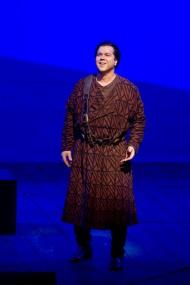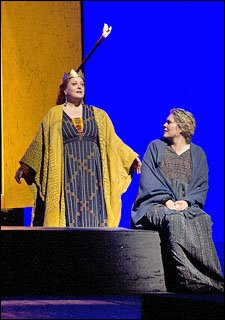Richard Wagner : Tristan und Isolde
« Simulcast » du Metropolitan Opera House de New York
Le samedi 22 mars 2008, à 12 h 30
Distribution (en ordre d'apparition vocale) : Matthew Plenk (matelot), Deborah Voigt (Isolde), Michelle DeYoung (Brangäne), Eike Wilm Schultze (Kurwenal), Robert Dean Smith (Tristan), Stephen Gaertner (Melot), Matti Salminen (roi Marc), Mark Schonwalter (un berger), James Courtney (un timonier)
Décors et costumes : Jürgen Rose
Éclairages : Max Keller
Chœurs et Orchestre du Metropolitan Opera House de New York dirigés par James Levine
On se souviendra longtemps des déboires qu’a connus la reprise de la production Dieter Dorn de Tristan und Isolde au Met, en 2008. Les malheurs ont commencé avant même la première représentation, lorsque Ben Heppner, qui partageait l’affiche avec Deborah Voigt, annonça son retrait pour cause de maladie. Il fut remplacé au pied levé par son compatriote, le Canadien John Mac Master qui, toutefois, ne devait monter sur scène que pour être frappé d’aphonie et se voir contraint de s’en retirer, sous les huées, après seulement deux soirées. (M. Mac Master est un excellent chanteur qui ne mérite pas une telle ignominie. Espérons qu’il s’en remettra.) Puis vint l’Américain Gary Lehman, dont tout le monde reconnaît qu’il s’est magnifiquement acquitté de sa tâche, non toutefois sans un accident spectaculaire qui aurait pu mal tourner et, surtout, le ridicule de voir sa diva lui tourner le dos et le planter là, en plein duo d’amour. Le pauvre homme, que l’on avait apparemment négligé d’informer que Mme Voigt était souffrante et risquait de ne pas terminer la soirée, était tellement ahuri qu’il continua de chanter sa partie tant que joua l’orchestre, et ce même après qu’on eût baissé le rideau...
C’était le vendredi 14 mars. Huit jours plus tard, le 22, dans la matinée du simulcast, Mme Voigt avait apparemment repris du mieux, assez en tout cas pour affronter son quatrième Tristan. Pour l’occasion, la direction du Met avait jeté son dévolu non sur M. Lehman, mais sur Robert Dean Smith, un autre Américain, un jeune Heldentenor très apprécié en Europe, mais que la maison new-yorkaise avait plus ou moins boudé jusque-là.
Il n’a pas déçu. En dehors d’un physique d’employé de la voirie, « Bob Smith » est doté d’une jolie voix, aussi robuste et puissante que fraîche et jeune, et pas du tout « barytonisante ». Cette voix, après en avoir fait un étalage au premier acte, il a eu l’intelligence de la ménager au deuxième acte, ce qui lui a assuré un triomphe dans son monologue du troisième, alors qu’il réussissait à faire ressortir de grandes beautés de long passage qui, en salle, ne font d’ordinaire que distiller le plus mortel ennui.
Mme Voigt a fait à peu près la même chose, mais avec des résultats inverses. Elle était au meilleur de sa forme au premier acte, et puis a eu l’air de se contenir au deuxième. En réalité il s’agissait davantage d’une retraite imposée à l’artiste par la fatigue et le déclin de ses moyens vocaux que d’un véritable repli stratégique. On a malheureusement pu le constater à la toute fin, lorsqu’elle s’est montrée incapable d’atteindre aux sommets du Liebestod.
On a donc eu droit cet après-midi à un Tristan assez différent de ce qu’on entend d’habitude, quand il s’agit surtout de tirer le meilleur parti de la fin du premier acte et de la première partie du deuxième jusqu’au monologue du roi Marc, soit les pages les plus connues, les plus propres à recueillir les faveurs du public. Dans ce cas-ci, tout s’est passé comme si, face aux défis de la grande scène d’amour qui constitue les deux premiers tiers de ce deuxième acte, les deux chanteurs avaient décidé, l’une de jouer la carte de la prudence, l’autre d’économiser ses moyens pour mieux les faire valoir par la suite, l’un et l’autre comptant sur le chef et l’orchestre pour pallier leurs « réticences ». Il en a résulté une représentation de l’œuvre où l’auditoire était invité à prêter l’oreille et mieux apprécier certains moments que ce n’est le cas d’habitude. Songeons ici notamment au monologue de Tristan, mais aussi à celui de Marc, ici enlevé de main de maître par Matti Salminen, ou à l’ensemble des rôles de Brangäne et de Kurwenal, dans lesquels Michelle DeYoung et Eike Wilm Schultze ont fait une excellente impression.
La production du Met, dirigée par James Levine, est la même que celle que l’on peut voir en DVD (sous étiquette Deutsche Grammophon) et qui met en vedette Ben Heppner et Jane Eaglen. La production en question, on le sait, est loin de faire l’unanimité. Il m’a toujours semblé pour ma part que, à la différence d’autres réalisations de l’œuvre, celle-ci a l’immense mérite d’introduire non seulement de la couleur, mais aussi du mouvement, voire de l’action, dans la plus scéniquement statique des grandes partitions wagnériennes. Hélas, l’auditeur qui ne connaîtrait cette production que par le simulcast qu’on en a fait n’aurait qu’une faible idée de ses qualités, car, ce jour-là, la direction du Met a commis l’erreur de jugement de permettre à son équipe de H(aute)D(éfinition) de capter et de diffuser la représentation sur une multitude d’écrans, jusqu’à une demi-douzaine ! L’artifice technique en question aurait pu contribuer quelque chose de positif à notre expérience artistique s’il avait été utilisé avec intelligence et parcimonie. Au lieu de cela, on a choisi de transformer le simulcast tout entier en une démonstration des diverses prouesses techniques de l’équipement utilisé, dont la capacité de réduire l’image de la scène à un format de « carte postale » dans lequel les décors et les chanteurs apparaissent comme encore plus minuscules que lorsqu’on les voit du fond du poulailler. Très bien, mais à quoi bon?
Quelques jours après ce désastre médiatique, la direction du Met a annoncé qu’elle n’avait pas l’intention de répéter l’expérience au cours de la présente saison. Le public lui en sera certainement reconnaissant.
En attendant, les simulcasts du Met continuent de faire fureur et l’exemple s’étend maintenant à plusieurs maisons européennes, dont la Scala de Milan.
-Pierre Marc Bellemare
Labels: High Definition, Metropolitan Opera, Tristan und Isolde, wagner






